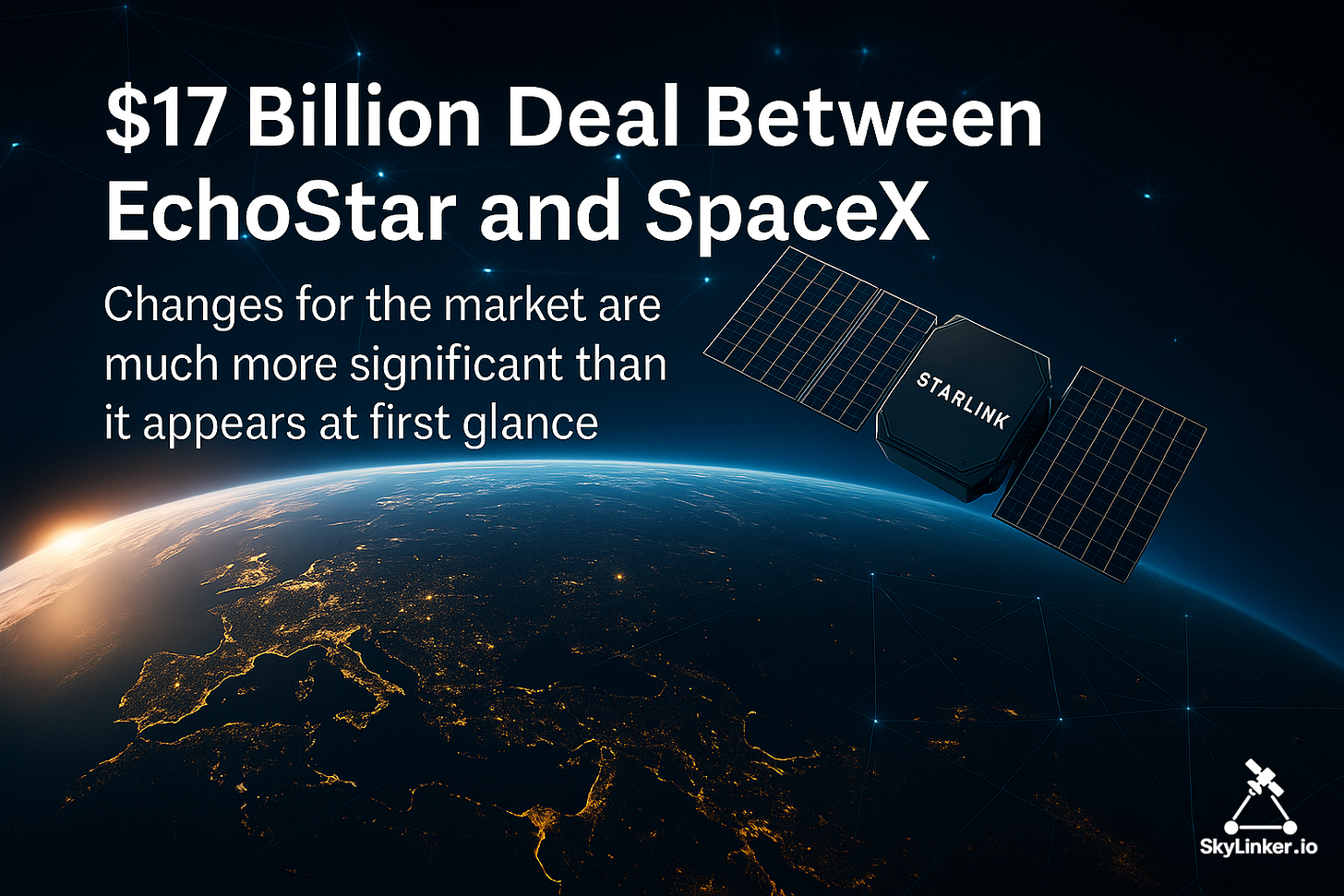EchoStar after the deal – the search for light in Starlink’s shadow
A financial lifeline, the loss of LEO plans, and a new strategic dependence on SpaceX
EchoStar announced the sale of its AWS-4 and H-block license portfolio to SpaceX for $17 billion and signed an agreement giving Boost Mobile access to Starlink Direct-to-Cell. This decision closes the door on EchoStar’s own LEO ambitions, strengthens SpaceX’s influence, and changes the balance of power in the U.S. satellite communications market.
Let’s look at this event from several angles. Many consequences of the deal have not been covered in the media, yet they are significant and fundamental for the industry as a whole.
The essence of the deal — if you missed the news
EchoStar agreed to sell spectrum to SpaceX for about $17 billion (≈$8.5 billion in cash + ≈$8.5 billion in SpaceX stock). A long-term commercial agreement was also signed: Boost Mobile will integrate Starlink Direct-to-Cell, and SpaceX will partly assist EchoStar with debt servicing.
Why this spectrum matters
The acquisition of EchoStar’s spectrum was a strategic breakthrough for SpaceX: the company for the first time gained ownership of wide AWS-4 and H-block licenses in the U.S., which are ideally suited for direct-to-smartphone satellite services. This removes Starlink’s dependence on complex partnerships with mobile operators and allows it to build Direct-to-Cell on its own frequency foundation.
For the market, this means that Starlink moves from the role of an experimenter to a full-fledged mobile player, capable of competing directly with terrestrial networks in critical coverage zones.
Why $17 billion became EchoStar’s “lifeline”
The deal with SpaceX was not just about abandoning ambitions, but about survival. For years the company balanced on the edge of an overloaded debt portfolio and regulatory demands regarding unused spectrum.
By the end of 2027, EchoStar faced multi-billion-dollar interest payments that threatened its ability to operate at scale. The license sale and SpaceX’s partial coverage of debt obligations effectively removed the threat of bankruptcy, giving EchoStar time and space to rebuild its business model around Hughes/JUPITER and Boost Mobile.
The end of EchoStar’s LEO projects
The sale of spectrum, which was the backbone of EchoStar’s direct-to-smartphone plans, effectively means abandoning the creation of a proprietary LEO constellation. The contract with MDA Space was terminated, and EchoStar no longer has the resources to launch similar initiatives.
Hughes/JUPITER: the front that remains
Hughes Network Systems remains EchoStar’s key “shop window.” The GEO-based JUPITER platform will continue to provide satellite internet services to millions of subscribers, corporate clients, and government customers. But now Hughes/JUPITER will operate without prospects of its own LEO developments, focusing instead on services and partnerships.
Boost Mobile and Direct-to-Cell
Boost Mobile gains a unique commercial advantage: direct access to Starlink Direct-to-Cell. This will allow users to stay connected outside terrestrial coverage and will be an important factor in the competitive MVNO environment. At the same time, Boost is now entirely dependent on the pace and scale of Starlink’s rollout.
The growing influence of SpaceX
The new deal creates several levels of dependence for EchoStar on SpaceX:
Financial — a portion of SpaceX shares on EchoStar’s balance sheet and assistance with debt servicing.
Commercial — Boost’s key service is based on Starlink.
Strategic — abandoning its own D2D projects has left EchoStar without alternatives.
For SpaceX, this marks the transition to owning its own spectrum for Direct-to-Cell in the U.S., enabling it to deploy the service without relying on third-party operators.
Technical perspective: Starlink and Hughes/JUPITER
There is no public evidence of JUPITER being integrated into the Starlink network.
Starlink retains its own infrastructure (LEO satellites, gateways, terminals).
Hughes offers managed solutions (SD-WAN, multi-transport networks), where Starlink can be one of the transports for enterprise customers.
Boost Mobile integrates Direct-to-Cell, but this is a separate commercial arrangement, not a technological merger.
Thus, the points of intersection are at the service and commercial level, not within the Starlink network core.
Market impact
EchoStar: exits LEO, betting on Boost and Hughes as service businesses.
HughesNet: GEO services remain relevant in B2B and government, but competitiveness in the mass segment decreases.
SpaceX: acquires a strategic resource (its own spectrum), strengthening its position in U.S. mobile communications.
Takeaways
EchoStar trades its LEO ambitions for financial stability and a partnership product. Starlink, in turn, secures key spectrum for Direct-to-Cell and consolidates control over the future of mobile satellite communications in the U.S. Hughes/JUPITER remains in play as a GEO platform and service wrapper, but now in close proximity to Starlink.
A note on MDA Space
I deliberately left out the detailed consequences of this deal for MDA Space. The cancellation of EchoStar’s LEO project was an unpleasant loss of a contract worth over $1.3 billion, but far from catastrophic. The company has a wide order portfolio in satellite platforms, robotics, and defense projects, so its production capacity can easily be redirected to other customers. In fact, this event merely freed up MDA resources that can now be used for promising government or commercial LEO and D2D programs — where demand currently far exceeds industry production capacity.


